Mount Wuyi Scenic Area (武夷山风景区) is nestled in the central part of the Wuyi Mountain Range within the jurisdiction of Wuyishan City, Fujian Province, covering approximately 60 square kilometers. Renowned for its typical Danxia landform, it features winding streams and 36 steep peaks nestled amidst cliffs, creating a picturesque landscape reminiscent of a jade-green landscape surrounded by waters.
The area boasts 18 ancient hanging coffins that have endured for millennia, suspended precariously on cliffsides. Additionally, it preserves the legacies of 35 historical academies where eminent scholars such as Zhu Xi, You Zuo, Xiong He, and Cai Yuanding once imparted knowledge. Mount Wuyi is also celebrated for its more than 450 cliffside inscriptions, considered a treasure trove of ancient Chinese calligraphy. Among them are 13 decrees dating back to ancient officials and villagers, advocating for the protection of Mount Wuyi’s waters, wildlife, and flora.
Over 60 temples and their remains, once inhabited by monks and Daoists, add to the cultural richness of the area. Mount Wuyi is divided into four main scenic sections: from Tianyou Peak to Taoyuan Cave, from Jiuxi Stream to Wuyi Palace, from Yixiantian to Huxiaoyan, and from Dahongpao to Shuilian Cave. The scattered distribution of attractions makes exploring the area a two to three-day affair rather than a one-day visit, typical of other tourist destinations.
For those with only a day to spare, starting with the panoramic views from Tianyou Peak and a stroll along the scenic Jiuxi Stream is recommended. Alternatively, exploring the tea fields along the Dahongpao to Shuilian Cave trail, with the aroma of tea filling the valley, offers a unique experience for tea enthusiasts and nature lovers alike.
Table of Contents
- Basic Information
- Location and Transportation
- Map of Mount Wuyi Scenic Area
- Highlights of Mount Wuyi Scenic Area
- Vlog about Wuyi Mountain
- Geology of Mount Wuyi
Basic Information
| Estimated Length of Tour | 1 – 3 days |
| Ticket Price | Admission and Sightseeing Bus: 70 RMB (valid for 1 day) 85 RMB (valid for 2 days) 95 RMB (valid for 3 days) Admission, Sightseeing Bus, and Bamboo Raft Drifting: 225 RMB (Valid for 3 days) Admission, Sightseeing Bus, Bamboo Raft Drifting, Qinglong Waterfall, and Tea Ceremony: 295 RMB (Valid for 3 days) Admission, Sightseeing Bus, Bamboo Raft Drifting, Xaimen Ancient Residential Complex, and Tea Ceremony: 270 RMB (Valid for 3 days) |
| Opening Hours | 6.30 – 18.00 (1st March – 31st October) 7.00 – 17.00 (1st November – 28th February) |
| Telephone Number | 0086-0599-5135110 0086-0599-5252884 |
Location and Transportation
Mount Wuyi, a UNESCO World Heritage site known for its stunning landscapes and rich cultural heritage, is located in Wuyishan City, Nanping, Fujian Province, China. The mountain straddles the border between the northwest regions of Fujian and Jiangxi provinces. To get there, you can choose one of the following ways:
By High-Speed Train:
- From Wuyi Shan North Station:
- Take Bus No. 6, 7, or 9 to reach the Wuyi Mountain Scenic Area or the South and North Entrance of the scenic area. These buses are convenient for direct access to the main attractions.
- From Nanping City Station:
- Option 1: Take the K1 bus (ticket price: 10 RMB) to the South Entrance of the scenic area or to various stops along the way to the resort area. The bus ride takes about 40 minutes.
- Option 2: Ride the Wuyi Mountain Tram (full fare: 10 RMB) to the South Entrance of the scenic area (Wuyi Shan Station). This scenic tram ride offers beautiful views of tea plantations along the route and takes around 40 minutes.
By Air:
- From Wuyi Mountain Airport:
- Upon arriving at Wuyi Mountain Airport, you can take Bus No. 6, 7, or 9 to the resort area, which provides convenient transportation to the scenic spots.
Map of Mount Wuyi Scenic Area

Highlights of Mount Wuyi Scenic Area
Precious Cultural Relics
Ancient Min-Yue Culture (古闽族文化)
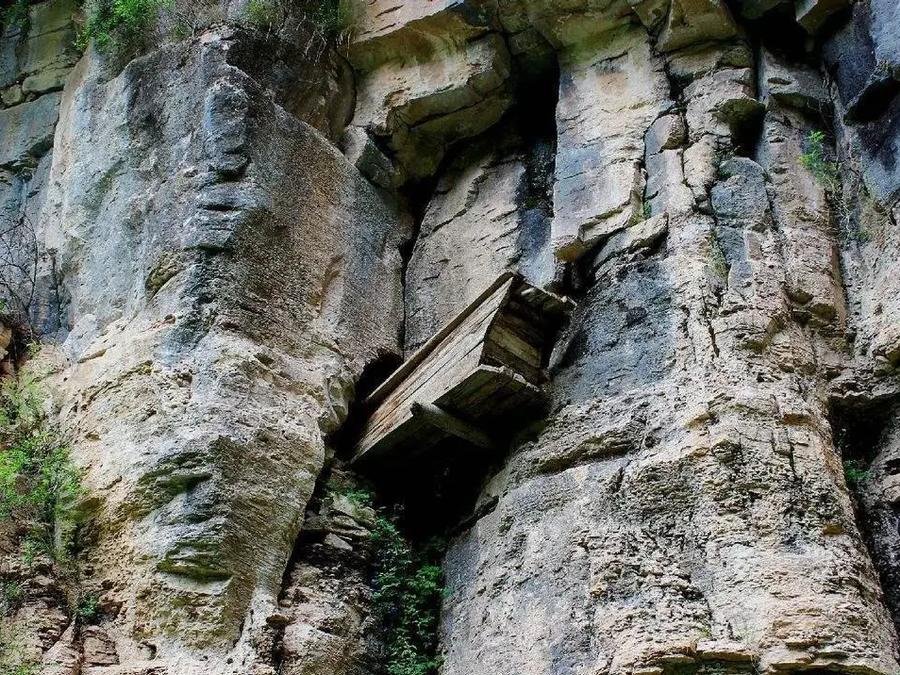
Mount Wuyi is deeply intertwined with the ancient Min-Yue culture, dating back over 4,000 years. It served as a cradle for the unique “Gu Min” culture, which evolved into the subsequent “Min-Yue” culture, lasting for over 2,000 years. This cultural legacy is evident in various archaeological finds, including:
- Hanging Coffins: Dating back over 3,750 years, these coffins are among the earliest discovered in China and abroad. Found in cliffside caves in eastern Mount Wuyi, they represent the earliest known cotton fabric remnants in China, offering invaluable insights into ancient burial practices and textile technology.
- Hongqiao Plank: Also found in the same area as the hanging coffins, these planks are significant cultural artifacts that provide evidence of early structural engineering and craftsmanship.
Han Dynasty City Ruins (古汉城遗址)

The Han Dynasty City Ruins of Mount Wuyi were added to the UNESCO World Heritage List in December 1999, recognizing their outstanding universal value. Spanning 48 hectares, these ruins are a testament to the Han Dynasty’s urban planning and architectural prowess. Excavations have unearthed a wealth of artifacts such as daily-use pottery, architectural materials, inscribed roof tiles, iron tools, and bronze artifacts. These findings illustrate the advanced technological achievements and cultural sophistication of Han Dynasty society, making the site pivotal for understanding the history of the Min-Yue people and the economic and cultural development of southern China.
Ehu Academy (鹅湖书院)
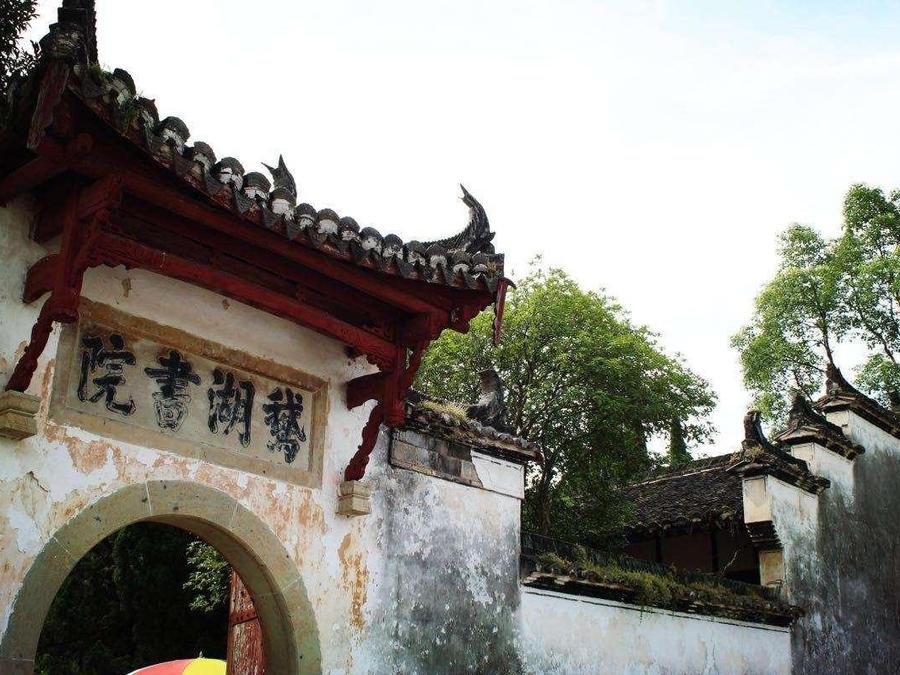
Ehu Academy, located in Yanshan County, Jiangxi Province, just north of Mount Wuyi, is a historic cultural landmark. Covering about 8,000 square meters, this academy was a renowned center for Confucian learning during the Southern Song Dynasty. It is most famous for the Ehu Meeting, where two prominent Confucian scholars, Zhu Xi and Lu Jiuyuan, debated key philosophical ideas that shaped Chinese Confucianism.
Established in 1087 AD and initially named Wenzong Academy, it was later renamed Ehu Academy. The academy became known as “the best academy in the world” during the Qing Dynasty’s Qianlong era. To honor the Ehu Meeting, a memorial hall called the “Four Sages Temple” was constructed behind the academy.
Today, Ehu Academy retains much of its original architecture and offers visitors a glimpse into the rich history of Confucian thought. The academy hosts exhibitions on the Ehu Meeting and the poet Xin Qiji, preserving its legacy as a center of cultural and intellectual significance.
Wuyi Palace (武夷宫)
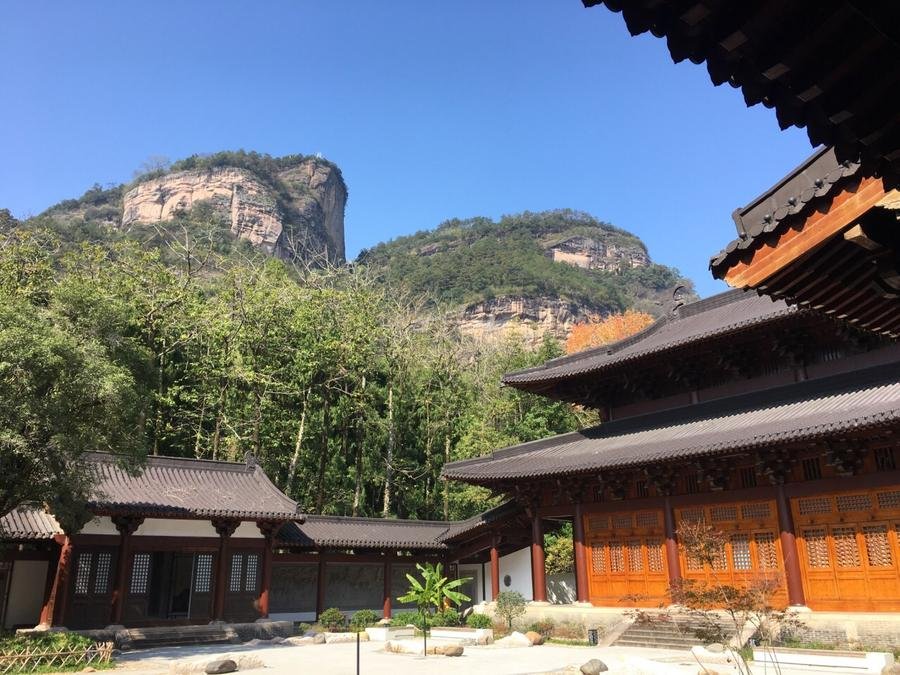
Wuyi Palace, also known as Huixian Temple, Chongyou Temple, or Wannian Palace, is a historic and spiritual landmark situated at the southern base of the majestic Dawen Peak in Mount Wuyi Scenic Area. Overlooking the entrance to the Nine-Bend Stream, the palace has served as a significant site for emperors to worship the deity of Mount Wuyi throughout Chinese history.
Originally constructed during the Tang Dynasty’s Tianbao period (742–755 AD), Wuyi Palace is the oldest palace in Mount Wuyi. Initially built on a small island in the river and called Tianbao Hall, it was relocated to its current site in 944 AD during the Southern Tang period and renamed Huixian Temple. The temple was later refurbished and renamed Chongyou Temple by various emperors who valued its spiritual significance.
In 1328 AD, the temple was elevated to Wannian Palace and continued to be a center of religious and cultural activities. Despite suffering from fires and wars, the palace was restored multiple times over the centuries. Between 2006 and 2008, with support from tourism and cultural departments, the main hall was meticulously restored, and two ancient osmanthus trees, dating back to the Song Dynasty, were preserved in the courtyard.
Stunning Natural Beauty
Huanggang Mountain (黄岗山)

Huanggang Mountain, the highest peak in southeastern China, stands at 2,160.8 meters above sea level and is often referred to as the “Roof of East China” and the “Pillar of Wuyi.” This peak is not only the highest summit in the Wuyi Mountain range but also a symbol of the natural splendor of the region.
Huanggang Mountain is renowned for its diverse vegetation zones, which transition smoothly from the base to the summit. Starting from the lowlands, visitors will encounter bamboo forests, transitioning to evergreen broadleaf forests, then to mixed broadleaf forests and coniferous forests, and finally reaching the alpine scrublands and meadows at the peak. This vertical vegetation gradient is a living showcase of the ecological diversity in the region, earning Huanggang Mountain the title of “Nature’s Masterpiece.”
Tianyou Peak (天游峰)
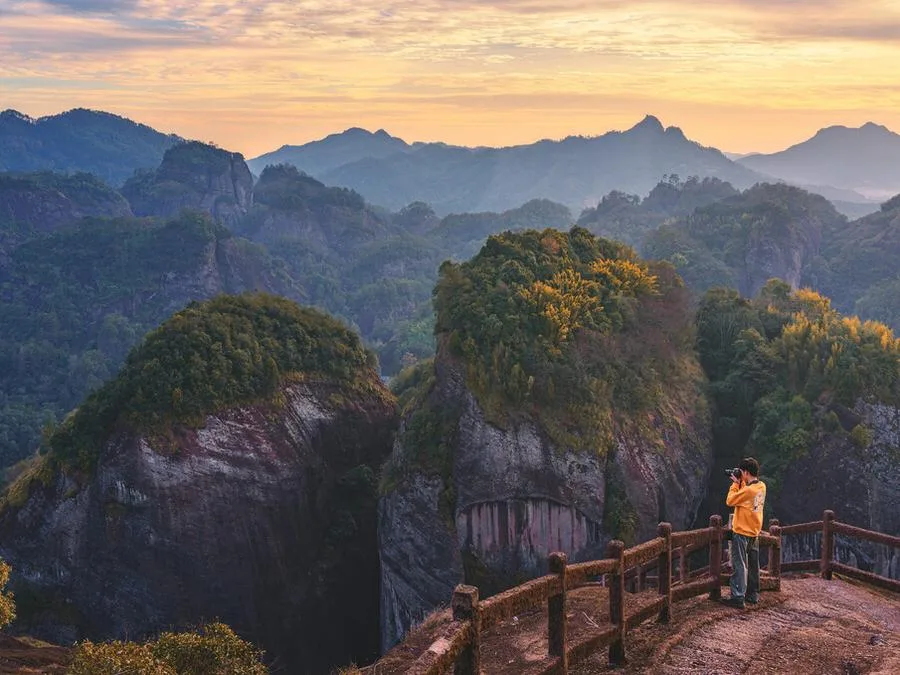
Tianyou Peak, rising to an elevation of 408 meters with a prominence of 215 meters, is one of the most iconic features of Mount Wuyi. This rock ridge extends from north to south, connecting to Xianyou Rock in the east and Xianzhang Peak in the west. The peak is characterized by its sheer cliffs and stunning vertical rock faces that seem to pierce the sky.
From the top of Tianyou Peak, visitors are treated to panoramic views of the surrounding mountains and valleys. The summit features a cascading spring known as Huoma Spring, with a drop of approximately 120 meters along the cliff face. The lush greenery of the evergreen broadleaf forest and ancient trees adds to the peak’s allure. Tianyou Peak is also home to numerous ancient stone inscriptions, including the notable “第一山 (First Mountain)” inscription by General Xu Qingchao of the Qing Dynasty, proclaiming Tianyou Peak as the “most magnificent place in Wuyi.”
Nine-Bend Stream (九曲溪)
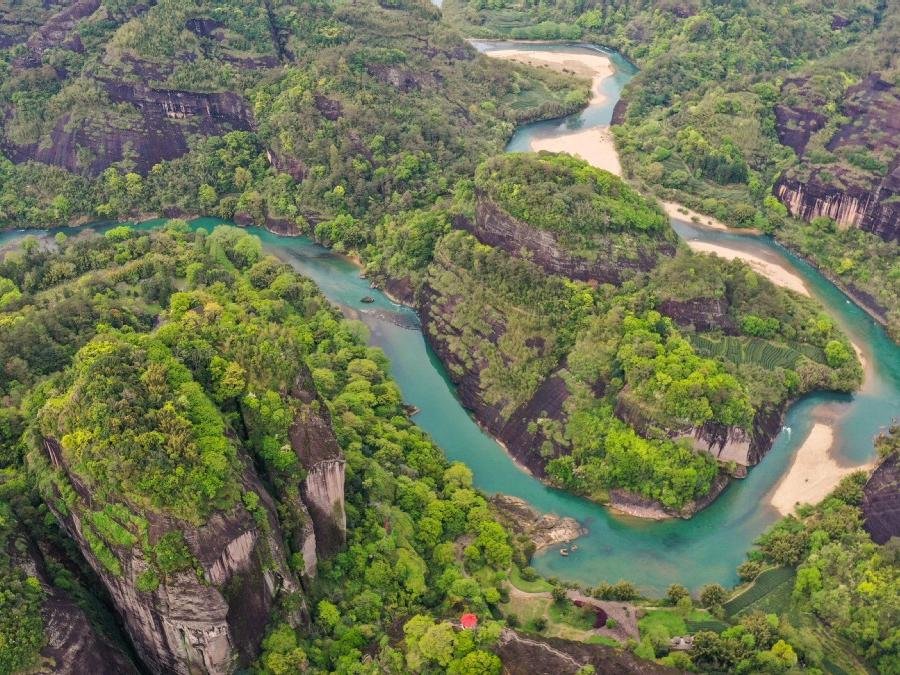
Nine-Bend Stream (Jiuqu Stream) is a pristine river that originates from the lush forests of the Wuyi Mountain Nature Reserve and stretches 62.8 kilometers through the scenic area. This stream is famous for its serpentine course, which winds dramatically through the landscape due to natural rock formations and fault lines. Over its 9.5-kilometer stretch within the scenic area, the river meanders with a total curvature of 1.9, creating a series of beautiful bends and twists that enhance its picturesque quality.
The clear waters of the Nine-Bend River are of exceptional quality, meeting the national Class I standard for surface water. The river’s tranquil waters reflect the surrounding verdant forests and dramatic cliffs, making it a perfect spot for serene boat rides and nature photography.
Dahongpao Scenic Area (大红袍景区)

The Dahongpao Scenic Area is situated in the heart of the Mount Wuyi Scenic Area, centered around the famous Jiu Long Ke (Nine Dragon Cave). This deep, narrow gorge is shaped by the east-west tectonic faults that have created a dramatic landscape of towering peaks and rugged rock formations. The gorge features nine steep, craggy peaks that rise in a striking display of natural geological beauty, with their unique, layered rock formations adding to the area’s charm.
At the base of this gorge, you’ll find the historic Dahongpao Tea Trees, growing on the sheer cliffs of the northern side. The tea plants are famed for their ancient lineage, with the current trees being over 340 years old. The site includes two traditional tea gardens arranged in a scenic, bonsai-like layout. The Dahongpao tea is one of the most prestigious oolong teas in China, and the leaves from these original trees were famously preserved in the National Museum of China in 2007. Today, visitors can admire the historic tea trees and learn about the ancient tea culture that has been integral to the region for centuries.
Shuilian Cave (水帘洞)
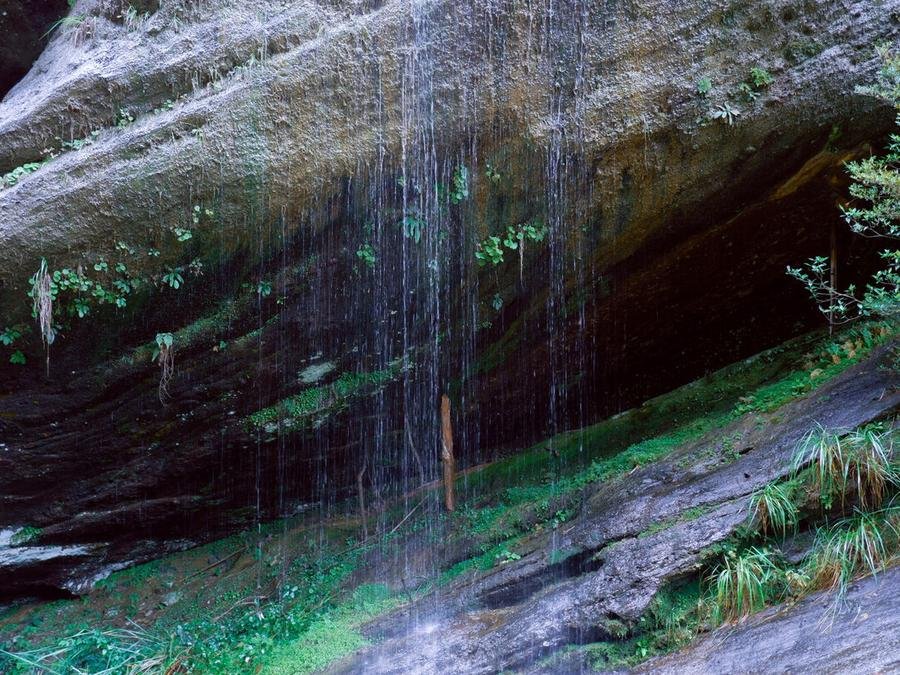
Shuilian Cave (Water Curtain Cave) is one of the renowned “Seventy-Two Caves of Wuyi Mountain,” located to the north of Zhangtang Stream. This picturesque spot is known for its dramatic natural features and serene environment.
The entrance to Shuilian Cave is marked by a small, cascading waterfall. As you ascend the stone steps, you’ll reach the main cave entrance, which is a grand, sloping arch surrounded by steep, verdant cliffs. Inside the cave, the cool, shaded environment offers a refreshing retreat from the heat of the outside world.
The highlight of Shuilian Cave is the impressive display of waterfalls that cascade down from over 100 meters of sloping rock faces. These waterfalls create a scene reminiscent of two flowing dragons, their misty sprays resembling delicate pearls suspended in mid-air. The sight of the water curtain cascading down and the sound of the rushing water create a tranquil and almost magical atmosphere for visitors.
Vlog about Wuyi Mountain
Geology of Mount Wuyi
Mount Wuyi, a renowned geological and natural landmark in China, features a complex and diverse geological composition that reflects its rich geological history. The geological structure of Mount Wuyi primarily consists of metamorphic rocks from the pre-Cambrian era, along with Mesozoic volcanic rocks, granite, and clastic sediments.
The geological evolution of Mount Wuyi began in the pre-Cambrian era with the formation of a metamorphic rock system, including schists and gneisses. These ancient rocks lay the foundation for the mountain’s geological framework. During the late Mesozoic era, particularly in the Cretaceous period, Mount Wuyi experienced intense volcanic activity. This period of geological upheaval resulted in the intrusion of large granite bodies into the region, contributing significantly to the current topography. The volcanic eruptions were followed by the deposition of red conglomerates, which are a key feature of the Danxia landform found in the area.
The unique Danxia landform of Mount Wuyi is characterized by dramatic red rock formations shaped by complex geological processes. The red sandstone conglomerates of the Cretaceous period, coupled with the region’s rich volcanic structures, created distinctive landforms such as steep cliffs, deep valleys, and rugged peaks. These features are the result of the combined effects of tectonic activity, erosion, and weathering.
The geological framework of Mount Wuyi is influenced by the East Asian Pacific Ring of Fire, a major tectonic zone known for its volcanic and seismic activity. The western part of Mount Wuyi is dominated by resilient tuff and rhyolite formations that form peaks exceeding 1500 meters in elevation. In contrast, the eastern part features extensive red sandstone and shale deposits, leading to the development of broad valleys and basins.



Wuyi Mountain has really beautiful scenery! As soon as you step into Wuyi Mountain, you feel so much oxygen in the air! I didn’t see any snakes, but I did encounter all sorts of strange bugs. What surprised me, though, was how hot it was at Wuyi Mountain! The climb wasn’t too exhausting since most of it was on stairs, although some parts were quite steep. On our way down, it suddenly started raining, which made it a bit cooler!… Read more »
The Water Curtain Cave currently has no water, so those visiting Wuyi Mountain recently can skip this attraction as it is quite a distance away. However, I highly recommend Tianyou Peak and the rafting experience; the scenery is exceptionally beautiful.
In early spring, searching for wild tea, sunbathing, and sitting on a bamboo raft in Wuyi Mountains is a delightful experience. March is a off-peak season, making it very pleasant. I brought my family here for a vacation, and the weather was not cold. In terms of physical exertion, you can still enjoy beautiful views without climbing mountains.
The weather is truly on our side. The past few days have been cloudy, but today we have a bright sunny day for hiking. We are so lucky!
It’s best not to visit Wuyishan in the winter. First, the Baiyun Temple lacks the lush green moss, resulting in photographs that come out gray and dull. Second, since winter is the dry season, the original 70-minute trip on the Jiuxi Bamboo Raft has turned into a 100-minute journey. The water is extremely cold, making it unbearable while sitting on the bamboo raft; I caught a cold that very night. Third, during winter’s dry season, there isn’t a single drop… Read more »
Wuyi Mountain is not very high in elevation, but it is particularly steep and treacherous. When you look around, it feels like you are surrounded by crumbling cliffs and ruins. After climbing Jin Jiao Chair (金交椅), Grass Sandal Fairy Rock (草鞋仙岩), and Niulan Pit (牛栏坑), I finally understood why the tea from these high mountains has such a rich flavor. The mountain paths are extremely perilous; even the stone steps laid out in some areas are barely wide enough for… Read more »
The mountain trails in Wuyi Mountain Scenic Area are quite pristine, with no tall buildings within the scenic area, only low-rise houses. The weather is great, there are mountains behind the houses, and the air is fresh.
Wuyi Mountain in September is too hot. After climbing just a few dozen steps up Tianyou Peak, I was out of breath and soon felt dizzy and nauseous.